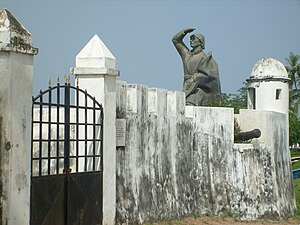Cacheu
| Cacheu | |
|---|---|

Fortress of Cacheu
|
|
| Location in Guinea-Bissau | |
| Coordinates: 12°16′14″N 16°09′57″W / 12.27056°N 16.16583°W | |
| Country |
|
| Region | Cacheu Region |
| Elevation | 44 m (144 ft) |
| Population (2009 census) | |
| • Total | 9,882 |
Cacheu is a town in northwestern Guinea-Bissau, lying on the Cacheu River. Its population was estimated to be 9,849 as of 2008[update].
The town of Cacheu is situated in territory of the Papel people. The name is of Bainuk origin: "i.e. Caticheu, meaning 'the place where we rest'."
Cacheu was one of the earliest European colonial settlements in sub-saharan Africa, due to its strategic location on the Cacheu river. Cacheu developed a European/Afro-European population from the late fifteenth century through informal settlement of Cape Verdian and Portuguese traders, adventurers and outcasts (lancados). The authorities in mainland Portugal also sent to Cacheu degredados - people condemned to exile for a variety of offences.
For most of the seventeenth and eighteenth centuries, Cacheu was the official slave trading point for the Portuguese in the Upper Guinea region - the point at which the Portuguese crown endeavoured to ensure that duties on all slaves exported were paid.
Notable buildings in Cacheu include the Portuguese-built 16th century fort, dating from the period when Cacheu was a centre for the slave trade.
Roads in the town are paved with oil palm kernels. Other attractions in the town include the Tarafes de Cacheu Natural Park mangrove swamp and a regular market.
Cacheu is twinned with:
Coordinates: 12°16′N 16°10′W / 12.267°N 16.167°W
...
Wikipedia

